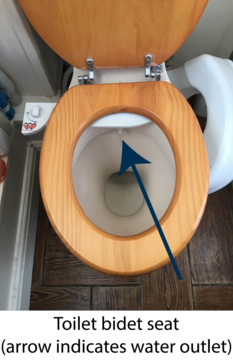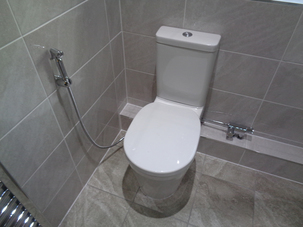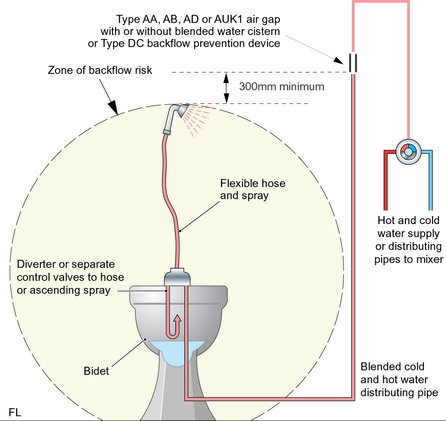Don't be a douche about hand showers
Amended July 2024
What the installer needs to know -
Nobody would expect or want to find water from the WC pan coming out of their kitchen tap. But across the UK faulty installation of ablutionary showers in homes could have this result.
Ablutionary showers are fittings designed for personal cleansing whilst using the toilet – hand showers, bidets, douches, toilet bidets seats all pose similar risks to the water supply system.
As illustrated in the Water Regulations Guide (now Guidance), every water system should contain adequate measures to prevent the backflow of fluid into the wholesome water supply from any appliance, fitting or process. The increasing popularity of ablutionary showers located next to WCs increases the potential for backflow incidents. Because of the location and how ablutionary showers and their intended use, there is a high risk of contamination to the drinking water supply. The risk is increased by the proliferation of some internet sites giving incorrect or incomplete advice on how to install these plumbing fittings.

Whilst ablutionary showers have always been common across continental Europe, recent years have seen them gain popularity in the UK.
However, water regulations and fitting guidelines for ablutionary showers installations in the UK are very different from those usually applied on the continent. The hazards posed by an ablutionary shower are particularly acute if they are installed incorrectly. The problem lies in the fact that many ablutionary showers, typically installed in the bathroom or in en-suites, can reach below the spill over level of WC pans or bidets. Many of these devices are not being installed with adequate backflow prevention, posing the risk of contaminated water getting back into the drinking water supply. A common error is installing a hose which could enter the bidet pan or reach other contaminated water in a WC, bath or washbasin.

The Water Fittings Regulations classify the risk of backflow from fluids which are in contact with ablutionary showers as a Fluid Category 5 – the highest possible risk level – because of the presence of faecal matter and bodily fluids. Fluid category 5 installations must have an adequate air-gap between the fitting and any contaminated fluids. One suitable arrangement for category 5 installations is illustrated using an “interposed cistern” with an air gap, known under regulations as a ‘Type AUK1 air gap’. This prevents water from the bidet or WC pan getting back past the air-gap at the inlet valve in the cistern and into the wholesome water supply.
Without the interposed cistern arrangement, there is a risk of contaminated water being syphoned back into the drinking water supply if the water pressure fluctuates.
Pressure changes can occur due to burst water mains, but also due to other users within the premises opening taps or other outlets at the same time as the ablutionary shower is in use. Some installers believe they can comply with the Water Fittings Regulations by placing a double check valve in the hose feed to prevent water travelling in the reverse direction. However, the Water Fittings Regulations state that a double check valve only provides protection against backflow to fluid category 3, so must not be used to provide backflow protection from ablutionary showers.
 When designing and installing these types of washing facilities the correct level of backflow prevention for fluid category 5 needs to be taken into consideration. Although ablutionary showers can be inherently difficult to install to required standards, there are some simple tips to ensure requirements are met. An independent supply pipe from a gravity fed cistern is often the easiest way to provide adequate backflow prevention, by means of a type AUK1 air gap arrangement. This can then be used to feed a dedicated water heater, where hot water is needed.
When designing and installing these types of washing facilities the correct level of backflow prevention for fluid category 5 needs to be taken into consideration. Although ablutionary showers can be inherently difficult to install to required standards, there are some simple tips to ensure requirements are met. An independent supply pipe from a gravity fed cistern is often the easiest way to provide adequate backflow prevention, by means of a type AUK1 air gap arrangement. This can then be used to feed a dedicated water heater, where hot water is needed.
Alternatively using a pipe interrupter (Type DC device) will work, however the design practicalities can prove difficult and other problems may arise from reduced water pressure and flow – so it is vital to give careful consideration before taking this route.
As a general rule, when installing these backflow protection devices, it is best to check the water supply system the homeowner has in place already, to ensure the most appropriate solution is being used.
Incorrectly installed ablutionary showers pose a risk to health so it’s vital installers do their research in order to ensure a safe and compliant method of installation.
Further resources for installing ablutionary showers correctly and in accordance with the legal requirements is available as a leaflet – in the resources section of our website – Prevention of the risk of backflow in the design of bathrooms.

